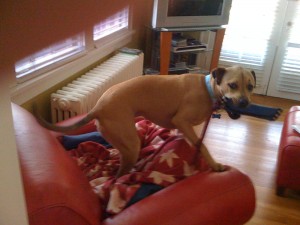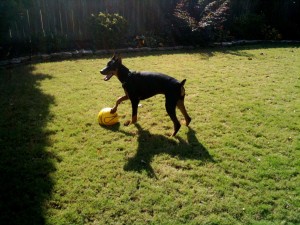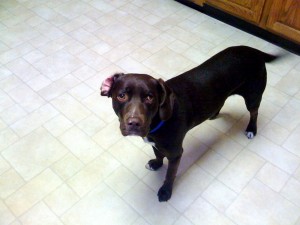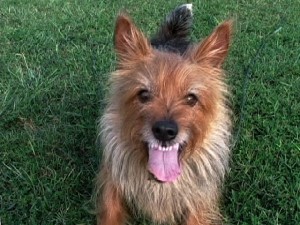 Physical needs are related to the physical well-being of the dog. Routine vaccinations are one example of physical health requirements.
Physical needs are related to the physical well-being of the dog. Routine vaccinations are one example of physical health requirements.
Grooming and bathing, quality food and clean water are other obvious needs. Shelter from environmental extremes and refuge from everyday household commotion are important for the physical health of your puppy.
The ability to move about, sufficient bathroom access, and daily exercise are components of physical needs.
Health Care
Routine Home, Health Inspections
Some health problems can be easily recognized by routine home, health inspections.
Ear infections are common, especially in dogs with floppy ears. If your dog is constantly shaking his or her head or scratching his or her ears, there’s likely to be an infection.
Ear infections are stinky. To determine if your pup’s ears are infected, place your nose directly into your pup’s ear and take a whiff. Do this a couple of times every week so you’ll notice any changes in the odor, before the infection develops into a serious problem. Contact your veterinarian if your dog’s ears are smelly!
Skin irritations are another common problem. Visually inspect your dog’s skin for signs of redness. In addition, you can sniff your dog’s skin. Any changes in the odor of your dog’s skin could be signs of a problem.
The consistency of your pup’s stools is another indicator of overall health. Generally speaking, you should be able to pick up your dog’s stools with a napkin. If your puppy has loose or runny stools, contact your vet.
Veterinarian Wellness Checkups
Wellness checkups are much more than disease protection and a quick once-over. Extensive blood work and a thorough examination are helpful for identifying potential health problems before they affect the life of your animal. Blood chemistry results are compared and contrasted from year to year.
Comprehensive wellness exams provide veterinary professionals with a baseline for measuring the pet’s medical health.
Disease Prevention
Check with your veterinarian if you have any questions related to the prevention of global or regional health threats to your dog. I live in Memphis, TN. In the southeast, we have a saying.
There are two types of dogs, dogs that are always on heart worm and parasite prevention and dogs that are on the path to contracting parasites and heart worm disease.
Grooming
To all social mammals, grooming is a form of social interaction, a sort of bonding exercise.
Routine grooming has benefits beyond a neat coat. Brushing stimulates healthy skin. Grooming teaches your dog to accept handling, a most helpful coping skill.
Some puppies accept grooming and others view handling as an opportunity to bite. Please read subsequent chapters about socialization and play biting for tips on how to teach your pup to accept routine grooming.
Bathing
Bathing requirements vary greatly from breed to breed, as do ear and dental examinations. Check with your veterinarian and groomer about a schedule best suited to your dog.
Dental Care
Dental problems can develop into dangerous, life threatening conditions. Dogs with squashed faces (brachycephalic breeds) are at a higher risk for developing dental problems than breeds with a wolf-like muzzle. This is because the same number of teeth is condensed into a smaller area.
Dirty teeth can affect the health of the heart. Talk to your vet about starting a dental care program suitable for your breed.
There are many consumable products advertised to improve your dog’s dental health and breath. Chewing bones and other, hard, abrasive chew items can help to reduce tarter.
I’m not sure if eating a mint flavored chew item actually improves long-term breath or not. I have fed Bentley some of these and never noticed a long term change in the odor of his dog breath. Try some and see for yourself.
Diet Choices
Pet food is a multi-billion dollar industry. Choosing a food can be very frustrating because you will hear different advice from everyone.
If your dog is healthy and happy on his or her current diet, then my advice is to stick with that diet.
If your dog has chronic medical or behavioral health issues, then perhaps a diet change is warranted.
One of the first questions I hear from clients is, “What do you feed Bentley?”.
I feed Bentley a prescription diet purchased from my veterinarian because of his heath condition, chronic pancreatitis. A portion of his meal is canned food placed in a bowl. The remaining portion of his meals is dry food, delivered as treats when training.
Even though the ingredients are not what I consider to be of the highest quality, the balance of nutrition, fat, and protein is well suited for his medical condition.
Dry versus Wet Food
From a nutritional point of view, it stands to reason that wet or canned foods may contain more nutrients than their dry counterparts. Quality of ingredients, storage, and processing affect the nutritional value of all foods.
Many people claim that dry dog foods are better for dogs because dry foods help maintain clean teeth.
I’ll accept that dogs who actually chew dry food may receive some teeth-cleaning benefits from dry foods. But, I’ve met many dogs who only ate dry food and their teeth were very dirty. Maybe this is because they didn’t really chew the food or maybe it’s an individual trait of that dog.
For whatever reasons, some dogs need annual teeth cleaning by a veterinarian and other do not. Ask your vet for a teeth cleaning schedule that’s best for your dog.
Diet and Behavior
I am not a nutritional expert. I have absorbed information from those who I consider to be well educated in the field. I do know there is a link between diet and behavior.
Diet affects physical health. Physical health affects behavioral health.
Studies with children indicate that children who eat a balanced diet have a learning advantage over those who consume a less balanced diet.
Any parent will tell you that their child’s behavior is influenced by the amount of junk food the child consumes.
I always address diet when discussing problem behaviors.
There have been small studies about diet content and abnormal behaviors in animals. These studies claim that protein and carbohydrate levels can affect behavioral health.
My success with diet changes and behavioral improvements is unclear. Since I always present a multi-point behavior modification program which includes diet change, it’s difficult to measure the effects of the diet change.
In 1% of my behavior cases, changing the diet did cause dramatic improvements. I know this because the clients admittedly did nothing but change the dogs’ diets.
More apparent is the relationship between defecation and diet. Dogs who eat foods with more “junk” produce more, larger stools. Sometimes this can be a factor to consider while house training.
Commercial Foods
There are commercial foods marketed for toy dogs, working dogs, large breeds, puppies, adults, seniors, et cetera.
Some foods are advertised to be breed- specific, such as food especially for Yorkshire terriers.
I’m not sold on the necessity of selecting breed-specific foods, but I’m no expert. I avoid food marketed as suitable for all life stages.
Life-stage and weight control foods make sense to me.
Puppies require different levels of nutrients than seniors. Seniors need different levels of fiber, fat, protein, etc., than younger dogs. Overweight dogs should consume fewer calories.
Contact your veterinarian with any questions regarding the best food for your individual dog at his or her current life stage.
Rendered Foods
Dog foods contain ingredients that originate from the same sources as our people food. Lamb, rice, chicken and vegetables are common ingredients. The quality is usually of a lower grade than served to people.
Most commercial dry dog foods are rendered so that we can easily store and serve the product. Rendering is a type of heated reduction or extraction process in which fat soluble and water soluble products are separated from solid products.
Homemade Diets
There are some who profess that a B.A.R.F. diet is the best for our canine companions. Bones And Raw Food make up the B.A.R.F. diet. I haven’t been exposed to studies about the effectiveness of the diet, but I believe the B.A.R.F. diet has merits.
Many people prefer to make their dogs’ food. There’s no question that fresh foods are more nutritious than processed foods. I have no doubt that some people research and learn how to meet the nutritional requirements of their pets. Their dogs may indeed live longer, healthier lives than dogs on commercial diets of lesser quality.
Some of my concerns with homemade diets are related to balance and life stages.
Unless the people follow a well researched recipe, the animal may not receive necessary nutrients in the ideal quantities. In addition, life stage nutritional requirements may be overlooked in home made diets.
Another concern when discussing home made diets, especially the B.A.R.F. diet, is a group of bacteria known as salmonella.
Improper handling of raw foods places humans and pets at risk for illness.
Common symptoms of salmonella infection are diarrhea, fever, or abdominal cramps.
Frozen & Organic Diets
There are alternatives for those who do not want to prepare home made foods nor feed a traditional dog food. Frozen and freeze dried raw diets as well as organic dog foods are other choices.
I question some claims posted by some niche-food manufacturers.
I wonder how a very small company can purchase organic ingredients, process, package, (sometimes freeze), and ship the finished product for a fraction of the cost I would incur by only purchasing the same ingredients.
Add in the cost of business and payroll taxes, insurance, various other business expenses plus a small profit and the math simply does not support their claims.
These and other non-traditional dog food selections might be good choices for those who want to purchase a higher quality diet, assuming the maker follows sanitary guidelines, has a nutritionist on staff, and uses the stated ingredients in quantity.
Table Scraps
Some people feed their dogs table scraps. Others pride themselves on never feeding people food. Some randomly toss food to their dogs when eating at the table.
Feeding dogs from the table can create a begging, obnoxious dog or can create a wonderfully polite dog! It depends on the timing of the delivery. If you toss a bite immediately after your dog whines or barks, then obnoxious behaviors will increase. If you toss a piece when your dog is waiting quietly, then polite behaviors will increase.
Feeding table scraps might temporarily upset your dog’s digestive system.
In some instances, ingesting large quantities of high fat table scraps can permanently affect a dog’s digestive system.
I never feed Bentley substantial quantities of table scraps, but he does get people food.
Feeding table scraps will aggravate Bentley’s chronic pancreatitis.
I often let Bentley lick my empty plate. If he waits quietly and patiently, I rinse the plate and place it on the floor. Bentley doesn’t really get any food or food juices from the rinsed plate.
People Food Treats
Some people food can be used as training treats.
I often use carefully selected people food for training treats.
Many of my clients use boiled chicken, turkey, other low-fat meats, organic cereals, and bits of fruits and vegetables. All these are great training treats. Unsalted, plain popcorn is another favorite.
I do not feed high fat, high salt treats like corn and potato chips as well as any candy, cakes, ice cream or sweets.
Happy Training!
Alan J Turner
Canine Behavior Counselor – Memphis TN
Aggression, Fear, Puppy Manners, Obedience – Private and Group Animal Training and Behavior Services
 Resource guarding is when dogs posture, growl, snarl, bark, snap, lunge, or bite for reasons we believe are efforts to keep other animals or people away from what they consider to be valuable resources.
Resource guarding is when dogs posture, growl, snarl, bark, snap, lunge, or bite for reasons we believe are efforts to keep other animals or people away from what they consider to be valuable resources.



